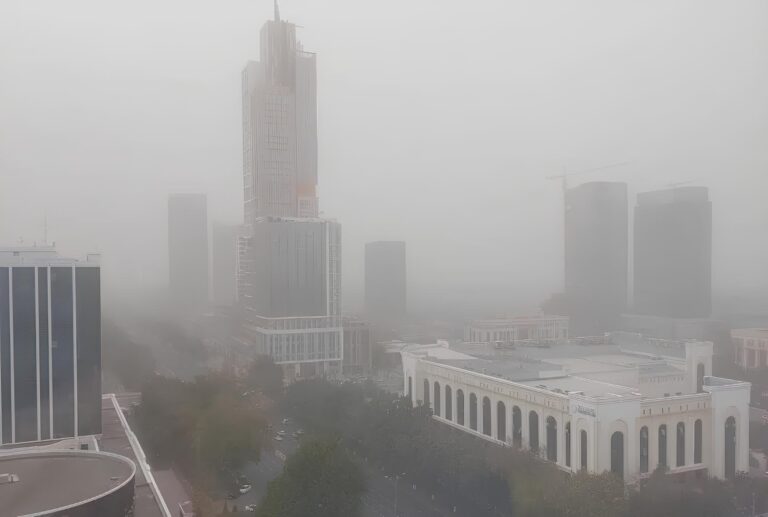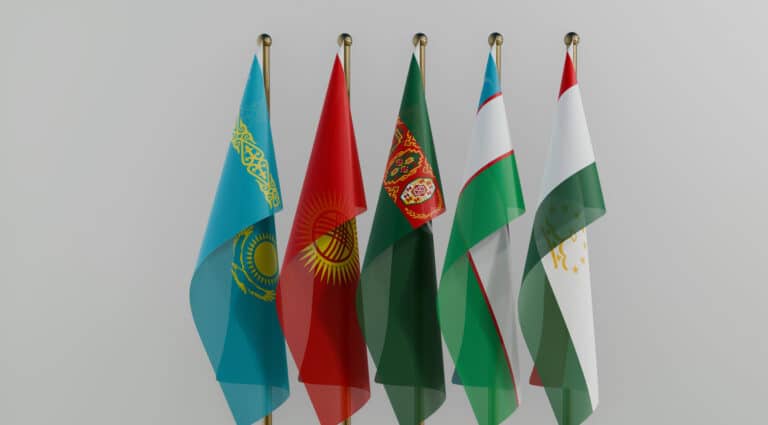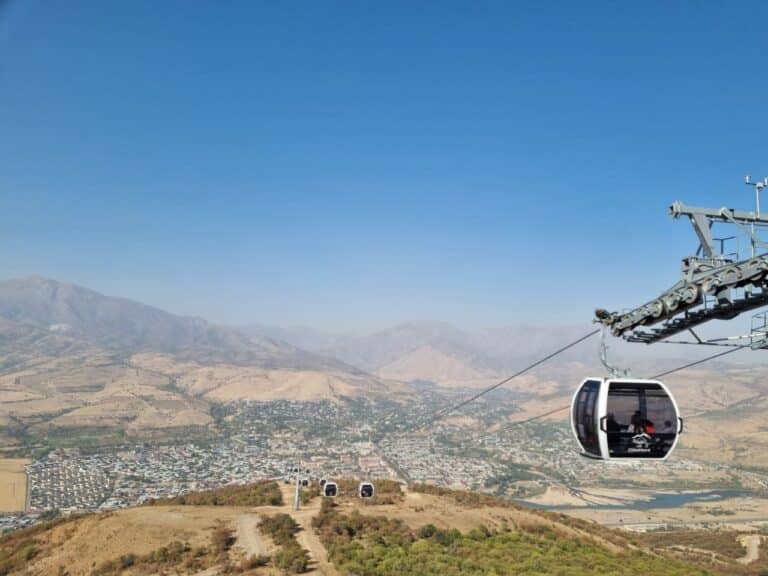In terms of tourism, Uzbekistan is primarily known for its ancient cities of Samarkand, Bukhara and Khiva. However, there are several completely new directions available for tourists. Among them are unique historical sights, nature monuments and brand-new cultural sites, which attract travelers from all over the world. The Kursiv edition has prepared a list of the top 10 new routes for traveling across Uzbekistan.
Louvre in the desert
In the autonomous Republic of Karakalpakstan, which occupies almost a third of the territory of Uzbekistan, everyone can find something interesting that will match his interests. One of the main centers of attraction for those who travel across the region is the Savitsky Museum of Art. It is located in the city of Nukus and allows guests to observe the largest collection of Turkestani and Russian modernism from the first half of the twentieth century.
There are about 100,000 art pieces in the museum. Its art collection is the best in Asia and the second largest collection of the Russian avant-garde. In 2001, The Guardian described it as «one of the finest museums in the world.»
Karakalpakstan is located between two deserts — Karakum and Kyzylkum. The dried-up Aral Sea, which is now a symbol of an ecological catastrophe, has also become a tourist attraction. With its apocalyptic landscape and graveyard for sea ships in the former port of Muynak, the Aral Sea is a popular spot for professional photographers from all over the world. Also, this is a venue for Element, a festival of electronic music.
The region is tremendously rich with archaeological monuments. There are more than 300 archaeological sites on its territory, mainly from the times of the Khorezm civilization and the age of Zoroastrianism.
Switzerland in Uzbekistan
Ecotourists may be interested in visiting Zaamin National Park in the Jizzakh region; it’s located just two hours by car from Tashkent. The park, which occupies 26,840 hectares, also includes a nature reserve. It was established in 1968 in the Turkestan mountain range and accounts for 8,770 hectares. This land should help in preserving the unique juniper forests and local fauna. In heights, this mountain range varies from 1,670 to 4,200 meters above sea level.
The flora in Zaamin is so vivid that many describe this area as Uzbek Switzerland. There are about 700 species of unique plants growing in the park; 13 of them are considered endangered. The fauna of the park is also diverse. For example, bears and snow leopards live here.
At an altitude of two thousand meters above sea level, there is a health resort called Zaamin. Thanks to clean air and beautiful climate, this resort is popular for climatoprophylactic and climatotherapeutic procedures for children and adults who struggle with respiratory or nervous problems.
Homeland of Amir Timur
The famous commander Amir Timur was born in the small village of Khoja-Ilgar near Shakhrisabz in the Kashkadarya region. The history of the city goes back to the third century BC. In the annals of ancient Chinese history, this site was mentioned as the city of Sousse, which was the first local city to establish trade relations with China. In the second half of the second century BC, this town received another name – Kesh and served as the capital of Sogd — one of the Achaemenid empire provinces.
Later, Shakhrisabz became the first capital of the state of Amir Timur. Today the historic center of the city is included in the UNESCO World Heritage List. Many objects of the Timurid era are still there and can be observed. These include the remains of the fortress wall, built during the reign of Amir Timur, and the 57-meter-high ruins of the ancient palace Aksaray. Nearby are the Kok-Gumbaz cathedral mosque, the Dorut-Tilovat memorial complex, as well as the Dorus-Saodat, Shamsad-Din Kulyala, and Gumbazi-Seyidan mausoleums. The best option to reach the Shakhrisabz is the road from Samarkand, which goes through the Takhtakarach pass in the Zarafshan mountains. While you are on the way, you can enjoy all these beautiful views down the road.
However, Kashkadarya is famous not only for the hometown of Amir Timur. Other popular destinations are the Gissarak water reservoir 35 km away from Shakhrisabz, the GissarNational Park with its juniper forestry, four-thousand-meter-high peaks, deep caves, and canyons. The high-mountain villages of Gilan and Kul, located at an altitude of 2,300 meters above sea level, are also well known among tourists. This point is the beginning of a road to Khazrat Sultan, the highest peak in Uzbekistan (4,643 meters above sea level).
Oasis in Kyzyl Kum
Water sports lovers may be interested in Aydar Lake, a large artificial reservoir in the Aydar-Arnasay system of lakes, located in the northeastern part of Uzbekistan. The system of lakes includes three salt lakes: Aydarkul, Arnasay and Tuzkan, and covers a total area of about four thousand square kilometers. The lakes are located in a saline depression in the southeastern part of the Kyzyl Kum desert. The shores of the lake stretch from the Nurata district of the Navoi region to the Farish and Mirzachul districts of the Jizzakh region as long as 200 km.
The drainless lake Aydarkul is sometimes called the «sea in the sands» for its sandy beaches and saltwater. There are no settlements and highways near the lake but tourists can find here a bunch of guesthouses and camp grounds. Many love to spend their time at the lake for fishing.
Sarmyshsay — Travel to the Stone Age
In the Navoi region (45 km north-east of the city of Navoi), on the southern slope of the Karatau mountain, near the Kata-Karga pass, there is the Sarmyshsay area with petroglyphs of the Stone Age. According to the Institute of Archeology of the Academy of Sciences of the Republic of Uzbekistan, in the Neolithic Era (4th — 5th millennium BC) tribes of hunters and fishermen of the Celtaminar culture settled there. The convenient location of the area plus the availability of fresh water and animals made Sarmyshsay a sacred place where ancient people used to perform their rituals.
Petroglyphs of Sarmyshsay differ in age, style and plot. The vast majority of pictures are images of bulls, deer and goats dating back to the Stone and Bronze Ages. The ancient artists used the so-called animal style, which was typical for tribes of the Scythian circle (early Iron Age of the 9th-2nd centuries BC). The size of the Sarmyshsay «gallery of petroglyphs» is truly enormous — 20 square kilometers. According to some estimates, more than 10,000 petroglyphs were found in Sarmyshsay.
To Margilan for Silk
If you ask any Uzbek where the best silk product can be found, he would answer: in Margilan. According to legend, the name of the city is associated with Alexander the Great, who named it in honor of the dish «Murjinon», which locals presented him. The history of Margilan, located in the center of the Great Silk Road, dates back to the 2nd — 1st centuries BC.
Margilan is famous for its ancient traditions of making unique types of silk fabrics, created with help of the ancient abrbandi technique. To make a tissue colorful and unique, its threads should be split into various sections and then painted in different colors. Ornaments of Margilan fabrics are still considered a work of decorative and applied art.
In modern Margilan, there are three factories for the production of silk: Yodgorlik, Faizulodin and Atlas. However, there are many self-employed artisans. The Yodgorlik factory (established in 1972) is especially popular among tourists. For many decades, the manual method of producing antique fabrics on ancient wooden hand spinning machines has been carefully preserved here. Atlas Bayrami, the international festival of silk, is also held annually in Margilan, when more than 300 types of atlases, carpets, fabrics, and other products are available on display.
Kokand — the City of the Last Khans
Kokand is one of the oldest cities in Central Asia, even though it was mentioned as an independent city just in the 10th century. Since the 18th century, the city has become the capital of the Kokand Khanate and a local religious center. Due to its geographical location at the entrance to the Fergana Valley, Kokand was an important point on the Great Silk Road. Trade of various arts and crafts (pottery, woodcarving, etc.) were highly developed in the city. Today the city is a major handicraft center.
The most interesting architectural objects of Kokand were created in the 18th – 19th centuries when the Kokand Khanate reached a peak of its prosperity. Among them are the luxurious palace of the last ruler of the Fergana Valley Khudoyarkhan (19th century), Jami Mosque (late 18th — early 19th century), Norbut-biy madrasah (late 18th century), Madarikhan mausoleum (19th century), Emir Madrasah (18thcentury) and the tomb of Dakhma-i-Shakhon (XIX century). The palace complex of Khudoyarkhan was built in 1871 in the traditional style of Central Asian architecture. It’s known for its unique interior and exterior decoration painted in the oriental style.
There is the oldest Uzbekistani Museum of Local Lore in Kokand established in 1925. The road from Tashkent to Kokand winds through the picturesque mountain pass Kamchik, which is also known for its 19.2-kilometer railway tunnel. The city is also home to numerous artisan workshops that attract tourists with local products and souvenirs.
See the bridge in Karshi
Karshi is the administrative center of the Kashkadarya region of the Republic of Uzbekistan. In 2006, the city celebrated its 2700th anniversary.
The most interesting attraction of the city is the Karshi Bridge, built in 1583 in the Persian style. The structure has several names: Amir Timur Bridge, Sheibanid Bridge, Kashkadarya Bridge and Nikolaevsky Bridge. The construction of the building was launched on the initiative of Abdullah Khan II, who tried to make the settlement attractive for trade caravans. Since then, the bridge has become one of the symbols of the city.
There are many other historical monuments in Karshi including the memorial complex of the famous commander, politician, the Prophet companion and physician Muhammad Abu Ubayd ibn al-Jarrokh, the only Central Asian women’s madrasah and mosque of Odin (16th century), the Kok-Gumbaz cathedral mosque (16th century), Kilichboy madrasah (1914), and KhuzhaAbdulaziz madrasah (1909). There is also an old reservoir in Karshifor collecting water — Sardoba, built in the 14th century, and the old Karshi baths of the 16th century.
High-Mountain Observatory Maidanak
The Kashkadarya region also has one of the most amazing structures in Central Asia — the high-altitude observatory Maidanak. It was built in 1970 on the western part of the Maidanak plateau, 45 kilometers from Shakhrisabz as a permanent expedition of the Astronomical Institute of the Academy of Sciences of the Uzbek Soviet Republic.
According to several studies, the quality of the Maidanak images is 80% higher than images in any other place in the world. It is considered to be one of the best observatories in the Northern Hemisphere. In perfect silence, you can watch the sky through a telescope capable of seeing extragalactic objects.
Due to the harsh climatic conditions, the observatory is closed for the winter and opens only in the spring. On the way to Maidanak, there are several natural attractions: the LangarskyCanyon with 100-meter rocky walls, the Langar-ota mausoleum, an illegal salt mine where salt is still mined by hand, as well as the Bek-Terak mountain area.
Derbent’s Iron Gate
One of the most mysterious places in Uzbekistan and throughout Central Asia is the famous Iron Gate mountain pass in the Boysun district of the Surkhandarya region in the territory of the village of Derbent. Since ancient times, this opening played an important role as the shortest way between Bukhara, Samarkand and Tashkent to Bactria and India. It was used by trade caravans and ancient rulers’ troops.
The Iron Gate had been repeatedly mentioned in written sources by Chinese, Greek and Arab historians and geographers. For example, in 630, the Chinese traveler Xuanzang described this gorge as a defensive passage covered with iron and locked with two-winged gates. Another traveler, Arab geographer Al-Yakubi, who described the 9th-century city in Sogd, also mentioned this passage. The famous Spanish traveler Rui Gonzalez de Clavijo also passed through this gate while heading to Maverannahr for an audience with Amir Timur. He wrote that the gates protect the Samarkand kingdom from the side of India Minor, and also bring the city huge income every year.”












